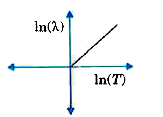A particle moves in a closed orbit around the origin, due to a force which is directed towards the origin. The de Broglie wavelength of the particle varies cyclically between two values λ1,λ2 with λ1>λ2. Which of the following statements are true?
The particle could be moving in a circular orbit with origin as centre
The particle could be moving in an elliptic orbit with origin as focus
When the de Broglie wavelength is λ1, the particle is nearer the origin than when its value is λ2
When the de Broglie wavelength is λ2, the particle is nearer the origin than when its value is λ1
The correct Answer is:B, D
Topper's Solved these Questions
- QUANTUM THEORYBOOK - CHHAYA PUBLICATIONCHAPTER - QUANTUM THEORYEXERCISE - Exercise (Multiple Choice Questions)
27 Videos
- QUANTUM THEORYBOOK - CHHAYA PUBLICATIONCHAPTER - QUANTUM THEORYEXERCISE - Exercise (Very Short Answer Types Questions)
37 Videos
- QUANTUM THEORYBOOK - CHHAYA PUBLICATIONCHAPTER - QUANTUM THEORYEXERCISE - NCERT Textbook Questions with Answer Hint
19 Videos
- OPTICAL INSTRUMENTSBOOK - CHHAYA PUBLICATIONCHAPTER - OPTICAL INSTRUMENTSEXERCISE - CBSE SCANNER
8 Videos
- QUESTION PAPER OF NEET 2017BOOK - CHHAYA PUBLICATIONCHAPTER - QUESTION PAPER OF NEET 2017EXERCISE - QUESTION PAPERS OF (NEET) (2017)
39 Videos
Similar Questions
A particle moves in a closed orbit around the origin, due to a force which is directed towards the origin. The de-broglie wavelength of the particles varies cyclically between two values λ1,λ2withλ1>λ2. Which of the following statements are true?
View SolutionA particle of mass 3m at rest decays into two particles of masses m and 2m having non-zero velocities. The ratio of the de Broglie wavelengths of the particles (λ1λ2) is
View Solution
Knowledge Check
A particle moves in a closed orbit around the origin, due to a force which is directed towards the origin. The de-broglie wavelength of the particles varies cyclically between two values λ1,λ2withλ1>λ2. Which of the following statements are true?
AThe particle could be moving in a circular orbit with origin as centre.BThe particle could be moving in an elliptical orbit with origin as its focus.CWhen the de Broglie wavelength is λ1, the particle is nearer the origin than when its value is λ2.DBoth (a) and (c )A particle moves in a closed orbit around the origin, due to a force which is directed towards the origin. The de-broglie wavelength of the particles varries cyclists between two valuse λ1,λ2withλ1>λ2. Which of the following statements are true?
AThe particle could be moving in a circular orbit with origin as centreBThe particle could be moving in an elliptic orbit with origin as its focusCWhen the de-broglie wavelength is λ1, the particle is nearer the origin than when its value is λ2DWhen the de-broglie wavelength is λ2, the particle is nearer the origin than when its value is λ1The graph showing the relation between de Broglie wavelength λ of particle and its temperature T is
A B
B C
C D
D
A praticle of mass M at rest decays into two particle of masses m1 and m2, having non-zero velocities. The ratio of the de Broglie wavelength of the particles λ1λ2 is
View SolutionWhich one of the following graphs in following figure represents variation of de Broglie wavelength (λ) of a particle having linear
View SolutionDue to transitions among its first three energy levels, hydrogenic atom emits radiation at three discrete wavelengths λ1,λ2, and λ3(λ1<λ2<λ3). Then
View SolutionA particle of mass 3m at rest decays into two particles of masses m and 2m having non-zero velocities. The ratio of the de Broglie wavelengths of the particles (λ1λ2) is
View SolutionA praticle of mass M at rest decays into two particle of masses m1 and m2, having non-zero velocities. The ratio of the de Broglie wavelength of the particles λ1λ2 is
View Solution
